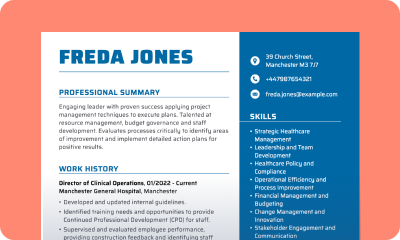- Our customers have been hired by : *Foot Note
A well-written translator CV shows employers that you can communicate with clarity, accuracy, and cultural understanding. Whether you specialise in technical, legal, medical or literary translation, your CV should reflect both your linguistic skills and professional experience.
Use our example CVs and expert writing advice to structure your application, highlight your language pairs, and demonstrate your attention to detail.
In this guide, you’ll find:
- Translator CV examples
- Editable translator CV templates
- How to write a translator CV step by step
- Best format for a translator CV
- FAQs about translator CVs
SEARCH ALL CV EXAMPLES
How to write a translator CV
Whether you’re an in-house translator, freelance language specialist, or applying to a localisation agency, your translator CV needs to show more than just fluency in languages. Use this guide to build a standout CV for translators, tailored to UK employers and international opportunities alike.
1. Begin with your contact details
Start your translator CV with professional, up-to-date contact information:
- Full name
- Email address
- Phone number
- City or town of residence
- Optional: Link to a professional portfolio, LinkedIn, or translation profile (e.g. ProZ.com)
2. Write a compelling personal statement
Your personal profile introduces you to the recruiter and should highlight your language skills, translation expertise, and career goals. Add one quantified accomplishment to immediately prove your value. Include:
- Job title or career stage (e.g. freelance translator, in-house translator, localisation specialist)
- Source and target languages
- Years of experience or major clients/projects
- Industry specialism (e.g. legal, medical, marketing)
- A measurable achievement
For example:
Qualified freelance translator with 5+ years’ experience translating from Spanish and French into English. Specialises in legal and marketing content, including contracts, press releases, and SEO web copy. Translated over 300,000 words in 2023 with a 99.6% on-time delivery rate. Confident using CAT tools and dedicated to delivering culturally accurate, high-quality translations.
3. Add relevant work experience
The work experience section of your translator CV should demonstrate your reliability, linguistic precision, and ability to deliver under deadlines. List roles in reverse chronological order, with clear accomplishments that show your value. For each role, include:
- Job title
- Employer or client (or indicate Freelance)
- Dates (month/year)
- Location (or Remote)
- 4–6 bullet points focused on impact, using action verbs and quantifiable results when possible
See this example:
Freelance Translator (Spanish & French to English)
Remote | Jan 2020 – Present
- Translated marketing, legal, and business texts for international clients across Europe and the UK
- Delivered over 300,000 words in 2023 with a 99.6% on-time delivery rate
- Regularly used CAT tools like Trados and MemoQ to improve consistency and productivity
- Collaborated with agencies and direct clients to localise product descriptions and contracts
- Edited and proofread colleague translations to ensure tone and terminology accuracy
4. Include a well-structured skills section
The skills section of your translator CV should showcase both your technical proficiencies (hard skills) and interpersonal strengths (soft skills). Employers want to know you can not only produce quality translations, but also communicate effectively and manage deadlines.
Hard skills relate to your language abilities and the tools you use to do your job. For example:
- Native or near-native fluency in English, Spanish, French, etc.
- Translation memory tools (Trados, MemoQ, Wordfast)
- Proofreading and editing
- Terminology management
- Localisation and transcreation
- Subtitling or voiceover skills
- Machine translation post-editing
- Knowledge of legal/medical/technical terminology
- DTP tools (e.g. InDesign, Adobe Acrobat)
Soft skills help you work well with clients and colleagues. Some examples include:
- Time management
- Cultural awareness
- Attention to detail
- Confidentiality and discretion
- Client communication
- Organisation
- Adaptability under pressure
- Self-motivation (especially for freelancers)
5. Showcase your education
Your educational background on a CV for a translator is especially important if you’re newer to translation or if you hold formal training in languages, linguistics, or law/medicine (for niche specialisms). Include the following:
- Degree or diploma
- Institution name
- Dates of study
- Optional: modules, dissertation, or achievements (if relevant)
For example:
BA (Hons) Translation & Interpreting
University of Westminster, London | 2016 – 2019
- Focused on Spanish-English and French-English translation, with coursework in legal and technical texts.
6. Present your language proficiency
This is one of the most critical sections in a translator CV. Use clear labels for source and target languages and include proficiency levels based on recognised standards. We recommend you use the CEFR (Common European Framework of Reference for Languages) or an equivalent framework.
For example:
- English – Native
- Spanish – C2
- French – C1
- German – B2
7. Strengthen your CV with bonus sections
This section builds trust and showcases your technical readiness. Use it to present:
- Certifications: DipTrans, ATA Certification, MA in Translation, Trados certification
- Professional memberships: CIOL, ITI, ProZ PRO
- Software/tools: SDL Trados, MemoQ, Smartcat, MS Office, Adobe Acrobat
- Portfolio or published work: Include links if publicly accessible
- Volunteering: Pro bono translation for charities or non-profits
8. Follow professional formatting standards
Keep your CV clean and easy to read to reflect your precision and clarity as a translator.
Translator CV writing – top tips
Wondering how to make your own application as good as our translator CV sample? These five simple tips will spell it out in plain English…
Tick the language boxes
A key feature of any good translator-interpreter CV sample is clarity when it comes to your specialist languages. Whether it’s Spanish, Mandarin, French or Portuguese, recruiters want to know that you specialise in the languages required for the role. While this might seem painfully obvious, recruiters receive plenty of irrelevant CVs for every role, so they need to make sure applicants tick this basic translation skills box before proceeding. Mentioning specific languages in your personal statement is the easiest way to do so.
Back up your linguistic prowess
Translation degree requirements can vary with some recruiters looking for a relevant Bachelor’s or Master’s, while others simply want fluency in your chosen languages. Whatever the case, it’s important that you back up your translator CV skills with some achievements or qualifications. Include a relevant degree if you have one, though a language proficiency test is another great way of showing your capability in your qualifications section.
Keep it concise and simple
One of the many translator skills CV-wise is the ability to interpret and deliver the right information in a clear and concise manner. Your in-house or freelance translator CV should reflect this by listing your own skills and responsibilities in the same manner. Like a translation CV template, sections should be well spaced out with clear subheadings, using bullet points to keep things concise. Try to avoid complex language or ‘jargon’, as it could make recruiters question your ability to convey things clearly.
Show progression in your translator career
Whether you’re applying for entry level customer service roles or mirroring a freelance translator CV sample later in your career, it’s important to show how you’ve progressed in your interpreter-translator career. That could be developing your skills in legal document translation in previous roles. Or if you’re writing a translator CV with no experience, you can detail how you’ve progressed from studying a language at school through to college, university, and eventually becoming fluent.
Top translator CV FAQs
What languages are in high demand for translators?
English is the most popular language to translate to or from. Spanish and Mandarin are in high demand, as they’re spoken by so many people around the world.
What diploma do you need to get to be a translator?
Translators should hold both a degree or other certification for fluency in their target languages, and a postgraduate qualification in translation.
How to become a translator (UK)?
To become a translator, you’ll need to be fluent in your chosen languages with the training and qualifications to back it up. The next step is to choose an industry or specialism, whether that’s proofreading legal documents or interpreting during business negotiations. Finally, translation careers (UK) require some experience, whether it’s voluntary work or an entry-level position.
How to become a certified translator?
There are a number of professional bodies such as the Chartered Institute of Linguists, which act as a form of certification for translators. To join, you need to meet admissions criteria for your chosen grade and typically pay a membership fee.
How much do translators make (UK)?
The average translator salary (UK) is around £30,000 per year. Your translator UK salary depends largely on your level of experience and specialist expertise. You can earn well above the translator average salary if you are an expert in legal translation, for example. Or you might earn below the typical translator yearly salary for entry-level roles like bilingual customer service.
Related Teaching CV: Examples, Templates, and Samples for 2025
Translator CV writing made easy
At myPerfectCV, we’re fluent in the language of recruiters – and we’re ready to help you build a CV for interpreter-translator roles. Use our in-house and freelance translator CV example to guide the way, then head to our online builder. You can choose from a range of to impressive pre-made CV templates then select professionally written content tailored to translator career requirements for your skills, work history, and professional summary.
*The names and logos of the companies referred to above are all trademarks of their respective holders. Unless specifically stated otherwise, such references are not intended to imply any affiliation or association with myperfectCV.




